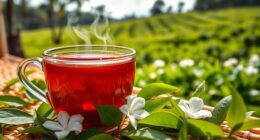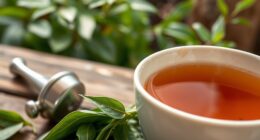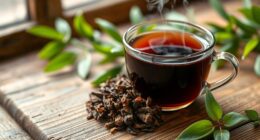To find teas with the highest ORAC scores, focus on minimally processed varieties like matcha and high-quality green teas, as their preserved antioxidants boost their capacity to neutralize free radicals. Processing methods like steaming or freeze-drying help retain polyphenols that contribute to antioxidant levels. Black and oolong teas typically have lower ORAC scores due to oxidation, but still offer health benefits. Keep exploring to discover detailed rankings and how processing influences antioxidant potency.
Key Takeaways
- Green teas generally have higher ORAC scores due to minimal processing preserving antioxidants.
- Matcha, a powdered green tea, often ranks highest because it contains whole leaf antioxidants.
- Processing methods like steaming or freeze-drying help retain or boost tea’s antioxidant capacity.
- Black teas typically have lower ORAC scores, but their oxidation products still contribute to antioxidant levels.
- High-quality, fresh teas with proper storage maintain higher ORAC scores, maximizing health benefits.

Understanding ORAC scores is essential if you want to evaluate the antioxidant capacity of foods and supplements accurately. ORAC, or Oxygen Radical Absorbance Capacity, measures the ability of a substance to neutralize free radicals, which can cause cellular damage and contribute to aging and disease. When it comes to teas, ORAC scores help you compare their antioxidant levels, but it’s important to recognize that these scores can vary widely based on how the tea is processed. Different tea processing methods considerably influence the antioxidant content, affecting the final ORAC score you see on labels or studies. For example, green teas generally retain more antioxidants because they undergo minimal processing, mainly steaming or pan-firing to prevent oxidation. This preservation of natural compounds results in higher antioxidant levels, which often translate into higher ORAC scores. On the other hand, black teas go through a full oxidation process that converts catechins into theaflavins and thearubigins, slightly reducing the overall antioxidant capacity. However, these oxidation products still contribute to the antioxidant profile, so black teas can also rank high in ORAC scores, albeit differently from green teas.
When you’re choosing teas based on antioxidant levels, understanding how processing impacts these compounds helps you make smarter decisions. For example, oolong teas are partially oxidized, placing their antioxidant profile somewhere between green and black teas. The exact ORAC score depends on factors like harvest time, storage, and specific processing techniques used by manufacturers. Some specialty teas undergo unique processing to preserve or enhance antioxidant content, such as steaming or freeze-drying, which can preserve delicate polyphenols. Consequently, not all teas are created equal, even within the same category, and processing methods can make a substantial difference in their antioxidant potential.
To get the most antioxidant benefit, opt for minimally processed teas like matcha or high-quality green teas, which tend to have higher antioxidant levels reflected in their ORAC scores. Keep in mind, though, that the tea’s origin, freshness, and storage conditions also influence its antioxidant content. When reading labels or research reports, look for details on processing methods, as these give clues about the expected antioxidant levels. Ultimately, understanding how tea processing methods influence antioxidant levels can empower you to select teas that maximize health benefits. While ORAC scores are a helpful guide, combining this knowledge with a focus on high-quality, well-preserved teas ensures you’re getting the most out of your tea-drinking habits.
Frequently Asked Questions
How Accurate Are ORAC Scores in Predicting Health Benefits?
You might wonder how accurate ORAC scores are in predicting health benefits. While they measure antioxidant variability, these scores don’t always directly correlate with health outcomes. You shouldn’t rely solely on ORAC values, as other factors like bioavailability matter. Focus on a balanced diet and nutrient-rich teas instead, since the health correlation isn’t absolute. ORAC scores offer some insight but aren’t definitive indicators of overall health benefits.
Do ORAC Scores Vary Between Organic and Non-Organic Teas?
You might wonder if ORAC scores differ between organic and non-organic teas. Organic variability can influence antioxidant levels, leading to differences in ORAC scores. Non-organic teas sometimes contain fewer antioxidants due to pesticide use or farming practices. While ORAC scores can reflect these differences, they don’t tell the full story about health benefits. So, consider both organic status and antioxidant content when choosing your tea for health.
Can Brewing Methods Affect the ORAC Score of a Tea?
Brewing methods definitely impact the ORAC score of your tea. When you focus on tea steeping and brewing temperature, you control how many antioxidants release into your cup. Hotter temperatures tend to extract more antioxidants, boosting the ORAC score, while longer steeping times can also increase antioxidant levels. So, by adjusting your brewing temperature and steeping time, you can maximize the health benefits of your tea.
Are Higher ORAC Scores Always Better for Health?
Think of ORAC scores as a mirror reflecting antioxidant potency. While higher scores often suggest stronger antioxidants, they don’t always translate to better health. You might be tempted to chase the highest number, but real benefits depend on how your body absorbs and uses these compounds. So, focus on variety and balance, knowing that a tea’s true value lies in its overall contribution to your health, not just its score.
How Often Do ORAC Scores Get Updated or Revised?
You wonder how often ORAC scores get updated or revised. Typically, score updates depend on new research, testing methods, and batch variations. Revision frequency varies, but it’s common for organizations to review data annually or whenever significant scientific discoveries occur. Keep in mind, these updates help ensure accuracy, so staying informed about the latest score revisions can guide you toward healthier tea choices.
Conclusion
Now that you understand how ORAC scores shine a light on antioxidant power, remember, they’re like a map guiding you through a forest of teas. While high scores hint at potent health benefits, don’t forget to savor the journey, not just the destination. Each cup is a treasure chest of nature’s goodness, waiting to boost your wellness. So, brew with curiosity, sip with delight, and let these teas be your vibrant shield against life’s chaos.










